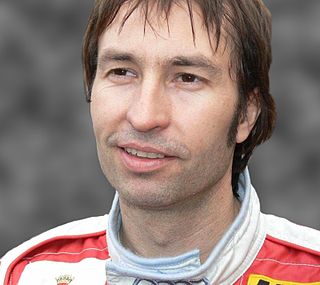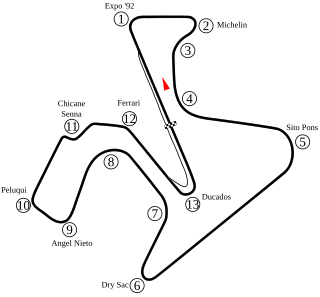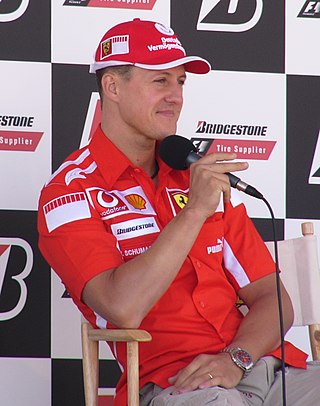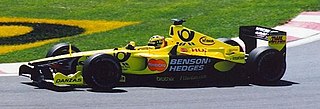
Peter Paul Sauber is a retired Swiss motorsport executive. He was the team principal and owner of various motorsports teams, most visibly the eponymous Sauber Formula One team.

Heinz-Harald Frentzen also known as H-HF, is a German former racing driver. He competed in multiple disciplines including Sportscars, Formula One and DTM. He had his most success in Formula One, entering over 150 Grands Prix and winning three.

Karl Wendlinger is an Austrian professional racing and former Formula One driver.

The 1994 Brazilian Grand Prix was a Formula One motor race held on 27 March 1994 at the Autódromo José Carlos Pace, São Paulo. It was the first race of the 1994 Formula One World Championship.

The 1994 European Grand Prix was a Formula One motor race held on 16 October 1994 at the Circuito Permanente de Jerez, Jerez, Spain. It was the fourteenth race of the 1994 Formula One World Championship.

The 1995 Monaco Grand Prix was a Formula One motor race held on 28 May 1995 at the Circuit de Monaco, Monte Carlo, Monaco. It was the fifth round of the 1995 Formula One season. The 78-lap race was won by Michael Schumacher for the Benetton team after starting from second position. Damon Hill finished second for Williams after starting from pole position and leading the first 23 laps of the race, ahead of Gerhard Berger in a Ferrari car. The remaining points-scoring positions were filled by Johnny Herbert in the second Benetton, Mark Blundell (McLaren) and Heinz-Harald Frentzen (Sauber). Schumacher's win was his third of the season thus far and extended his lead in the World Drivers' Championship over Hill to five points. It was also Renault's first win in the Monaco Grand Prix, as Benetton's engine supplier.

The 1995 Japanese Grand Prix was a Formula One motor race held at the Suzuka Circuit, Suzuka on 29 October 1995. It was the sixteenth and penultimate race of the 1995 Formula One World Championship. The 53-lap race was won from pole position by German Michael Schumacher, driving a Benetton-Renault, with Finn Mika Häkkinen second in a McLaren-Mercedes and Schumacher's British teammate Johnny Herbert third.

The 1995 Australian Grand Prix was a Formula One motor race held on 12 November 1995 at the Adelaide Street Circuit, Adelaide. The race, contested over 81 laps, was the seventeenth and final race of the 1995 Formula One season, and the eleventh and last Australian Grand Prix to be held at Adelaide before the event moved to Melbourne the following year. This would also prove to be the last Grand Prix for Mark Blundell, Bertrand Gachot, Roberto Moreno, Taki Inoue and Karl Wendlinger.

The 2002 FIA Formula One World Championship was the 56th season of FIA Formula One motor racing. It began on 3 March and ended on 13 October after seventeen races.

The 1999 FIA Formula One World Championship was the 53rd season of Fédération Internationale de l'Automobile (FIA) Formula One motor racing. It commenced on 7 March and ended on 31 October after sixteen races.

The 1997 FIA Formula One World Championship was the 51st season of FIA Formula One motor racing. It commenced on 9 March and ended on 26 October after seventeen races. The Drivers' Championship was won by Jacques Villeneuve and the Constructors' Championship was awarded to Williams-Renault.

The 1996 FIA Formula One World Championship was the 50th season of FIA Formula One motor racing. The championship commenced on 10 March and ended on 13 October after sixteen races. Two World Championship titles were awarded, one for Drivers and one for Constructors.

The 1994 FIA Formula One World Championship was the 48th season of FIA Formula One motor racing. It featured the 1994 Formula One World Championship for Drivers and the 1994 Formula One World Championship for Constructors, which were contested concurrently over a sixteen-race series that commenced on 27 March and ended on 13 November. Michael Schumacher won his first Drivers' Championship driving for Benetton, while Williams-Renault won their third consecutive Constructors' Championship, the seventh in all for Williams.

The Jordan EJ11 was the car with which the Jordan team competed in the 2001 Formula One season.

The Sauber C20 was the car with which the Sauber Formula One team competed in the 2001 Formula One season. It was powered by a Petronas-branded '01A' 3.0-litre V10, supplied by Scuderia Ferrari. The C20 was notable not only for its eventual position in the Constructors' World Championship but also for a new type of front suspension mounting: the "twin keel".

The Sauber C13 was a Formula One car. It was designed by André de Cortanze and Leo Ress for use by the Sauber Team in the 1994 Formula One season. The car was powered by an Ilmor 3.5L V10 engine badged as a Mercedes-Benz. The development of this car signalled Mercedes-Benz's return to Formula One, providing their first engine for an F1 car since 1955. Drivers for the team throughout the season were Karl Wendlinger, Andrea de Cesaris, JJ Lehto and Heinz-Harald Frentzen. Only Frentzen drove for the entire season.

The Sauber C24 was a Formula One car built by Sauber for the 2005 season.
The Sauber C21 was the car with which the Sauber team competed in the 2002 Formula One season. The car was driven by Nick Heidfeld, Felipe Massa and Heinz-Harald Frentzen.

The Sauber C22 was the Formula One car that Sauber Petronas used to compete in the 2003 Formula One season.


















